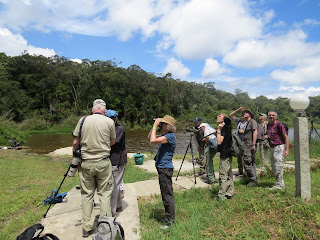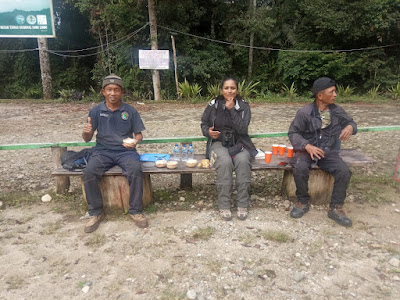Birding in Lore Lindu National Park
Huge national park in central Sulawesi and the best site for easily accessed montane endemics.
Key bird species:
Small Sparrowhawk; Bare-faced Rail; Sulawesi Woodcock; Metallic Pigeon; Ornate Lorikeet; Yellow-and-green Lorikeet; Ochre-bellied Hawk-Owl; Cinnabar Hawk-Owl; Speckled Hawk-Owl; Diabolical Nightjar; Scaly Kingfisher; Purple-bearded Bee-eater; Cerulean Cuckoo-shrike; Pygmy Cuckoo-shrike; Chestnut-backed Bush-Warbler; Blue-fronted Flycatcher; Sulawesi Blue-Flycatcher; Geomalia; Sulawesi Thrush; Great Shortwing; Olive-flanked Whistler; Maroon-backed Whistler; Malia; White-backed Woodswallow; Sulawesi Myna; Fiery-browed Myna; Mountain Serin
Birdwatching locations:
While the National Park of Lore Lindu is massive, the best birdwatching is concentrated is a pretty small area around the villages of Wuasa/Sedoa, Lake Tambing and the famous Anaso Track. Here you can find all of the high montane specialities of Sulawesi, including Great Shortwing, Geomalia and Sulawesi Thrush, plus much more.
Roadside birding around Lake Tambing
Driving from Palu, the road rises and rises until it reaches its highest point at around 1,700m. A few kilometres before the highest point lies a small lake known as Lake Tambing (Danau Tambing or sometimes Danau Kalimpaa), and a few hundred meters further back towards Palu lies the start of the Anaso Track. The birdwatching in this area is fantastic.

Working along the road, or around Lake Tambing should get you Ornate and Yellow-and-green Lorikeet (often in the big trees around the lake), Cerulean Cuckoo-shrike, Maroon-backed Whistler; Malia, Blue-fronted Flycatcher and many more of the more common Sulawesi endemics. This area, in particular between the lake and the Anaso turn off, is also among the most reliable for Sulawesi Thrush. Look for them from the roadside as they move about in the mid-storey, and be prepared to dive into the vegetation yourself to get a better look! Scaly Kingfisher has also been seen in this area. At night the road- and lakeside forest holds all three of mainland Sulawesi’s ninox owls: Ochre-bellied, Cinnabar and Speckled, plus the ever-present Sulawesi Scops-Owl. You could easily spend a day or two just in this area.
The Anaso Track
Moving onto the Anaso track, the lower sections are good for many of the same species as around Lake Tambing, plus your chance of seeing things like Pygmy Cuckoo-shrike, Maroon-backed Whistler and Purple-bearded Bee-eater increases. The bee-eater nests on many of the exposed earth banks along the lower half of the track, so if they are there, you will see them. Chestnut-backed Bush-Warblers also line the lower sections of the track. The Anaso track continues on upwards, with the habitat changing slowly as you rise. At around 2,000 m (3-4 km?) the track emerges into a few small flat clearings. It is here that people often see day-roosting Satanic Nightjars. Crashing around the clearing may flush one, but far better to move around slowly and try and spot one (or a pair) on the ground without disturbing them. The nightjars can also be seen hawking around this area at dawn and dusk if you don’t catch up with a day-roosting one.

From about 2,100 m the roadside forest becomes lower and mossier. Between here and the top the track passes through several dense patches like this and these are the spots to look out for a couple of Lore Lindu’s most sought-after specialities: Geomalia and Great Shortwing. For the Geomalia there is no real alternative than either walking slowly along the trail hoping to see one, or staking out a section and hoping one passes. Trying to get a view of one in the forest itself is extremely difficult. For the shortwing the same approach can work, or a tape of their call will help considerably! This area also holds both of the Sulawesi endemic honeyeaters; Dark-eared and Greater Streaked.

At about 2,300 m the Anaso track reaches its peak. It then drops slightly to a wide clearing, before continuing to the right as a less distinct footpath. The area of the clearing makes for good birding, with a good chance of Mountain Serin (the orange-coloured Sulawesi version) and the high altitude Olive-flanked Whistler. Continuing along the footpath (which descends at first) brings you back into habitat good for Great Shortwing after a few hundred meters.
In all the Anaso track is around 10km long. At times it is passable by 4×4 jeep, but this depends entirely on the state of minor (and major) landslides and improvised bridges. If you can’t drive it at the time of your visit, don’t despair, just start walking! (you’ll see more birds that way anyway). The Anaso track is definitely good for a couple of days of birding, or longer if you want to be sure of getting the goodies.
Road to Wuasa/Sedoa, Driving from Palu, the road drops down soon after Lake Tambing towards the villages of Sedoa and Wuasa at around 1,200 m. The roadside forest in this area is pretty degraded, but the birding along it is excellent nevertheless. Species commonly seen in this area include Fiery-browed Myna, Sulawesi Blue-Flycatcher, Malia and Cerulean Cuckoo-shrike. Other areas. Lore Lindu National Park is big, and the sites listed above all lie on the eastern edge of the park. Take a look at Google Earth to see the extent of forest extending to the west.
 |
| Starting point to Anaso Track |
 |
| Anaso Track |
 |
| Anaso Track |
 |
| Sedoa Valley |
Sulawesi
serpent eagle, Sulawesi goshawk, spot-tailed goshawk, small sparrow-hawk,
vinous-breasted sparrow-hawk, Sulawesi hawk-eagle, Maleo, Snoring rail, Blue-faced
rail, Isabeline waterhen, Sulawesi woodcock, Sulawesi black pigeon, Sulawesi
ground-dove, Red-eared fruit-dove, White-bellied imperial pigeon, Grey-headed
imperial pigeon, White imperial pigeon, Sombre pigeon, Ornate Lorikeet, Yellow
and Green Lorikket, Yellow-vented Racquet-tail, Golden-mantled racquet-tail,
Large Sulawesi hanging parrot, Small Sulawesi hanging parrot, Black-billed
Koel, Yellow-Billed Malkoha, Bay Coucal, Sulawesi Masked Owl, Minahasa Masked
Owl, Sulawesi Scops Owl, Ochre-bellied boobook, Speckled Boobook, Cinnabar
Boobook, Satanic Nightjar, Sulawesi Nightjar, Green-backed Kingfisher,
Scaly-breasted Kingfisher, Lilac-cheeked Kingfisher, Great-billed Kingfisher,
Sulawesi dwarf Kingfisher, Purple-bearded Bee-eater, Purple-winged Roller, Sulawesi
Dwarf Hornbill, Red-Knobbed Hornbill, Sulawesi Pygmy Woodpecker, Ashy
Woodpecker, Caerulean Cuckoo-shrike, White-rumped Cuckoo-shrike, Pygmy
Cuckoo-shrike, Sulawesi Cicadabird, Sulawesi Triller, Sulawesi Drongo, Piping
Crow, Sulawesi babbler, Malia, Geomalia, Great Shortwing, Red-backed Thrush,
Sulawesi Thrush, Chesnut-backed Bush-warbler, Sulawesi Leaf-warbler,
Henna-tailed Rhynomias, Rufouss-throated Flycatcher, Blue-fronted
Blue-flycatcher, Rusty-bellied Fantail, Yellow-flanked Whistler, Maroon-backed
Whistler, Yellow-vented Whistler, Ivory-backed wood-swallow, Sulawesi crested
Myna, White-necked Myna, Fiery-browed Myna, Finch-billed Myna, Lesser Sulawesi
Honeyeater, Greater Sulawesi Honey eater, Crimson-crowned Flowerpecker,
Grey-sided Flowerpecker, Sulawesi White-eye, Streak-headed Dark-eye,
Pale-headed Munia.
 |
| Lake Tambing, Lore Lindu National Park |
 |
| Birding along roadside near Lake Tambing |







.jpeg)





















































